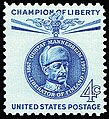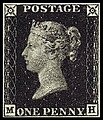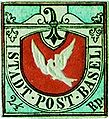Portal:Philately
| Philately portal | WikiProject Philately |
The Philately Portal
Philately is the study of revenue or postage stamps. This includes the design, production, and uses of stamps after they are issued. A postage stamp is evidence of pre-paying a fee for postal services. Postal history is the study of postal systems of the past. It includes the study of rates charged, routes followed, and special handling of letters.
Stamp collecting is the collecting of postage stamps and related objects, such as covers (envelopes, postcards or parcels with stamps affixed). It is one of the world's most popular hobbies, with estimates of the number of collectors ranging up to 20 million in the United States alone.

The Apollo 15 postal covers incident was a 1972 NASA scandal involving the astronauts of Apollo 15, who carried about 400 unauthorized postal covers into space and to the Moon's surface on the Lunar Module Falcon. Some of the envelopes were sold at high prices by West German stamp dealer Hermann Sieger, and are known as "Sieger covers". The crew of Apollo 15—David Scott, Alfred Worden, and James Irwin—agreed to take payments for carrying the covers; though they returned the money, they were reprimanded by NASA. Amid much press coverage of the incident, the astronauts were called before a closed session of a Senate committee and never flew in space again.
The three astronauts and an acquaintance, Horst Eiermann, had agreed to have the covers made and taken into space. Each astronaut was to receive about $7,000 (equivalent to $51,000 in 2023). Scott arranged to have the covers postmarked on the morning of the Apollo 15 launch on July 26, 1971. They were packaged for space and brought to him as he prepared for liftoff; he brought them aboard in a pocket of his space suit. They were not included on the list of the personal items he was taking into space. The covers spent July 30 to August 2 on the Moon inside Falcon. On August 7, the date of splashdown, the covers were postmarked again on the recovery carrier USS Okinawa. One hundred were sent to Eiermann (and passed on to Sieger); the remaining covers were divided among the astronauts. (Full article...)
Selected article -

In philately, errors, freaks, and oddities (EFO) collectively refer to the wide variety of mistakes that may occur during the production of postage stamps.
Postal authorities generally take some care to ensure that mistakes do not get out of the printing plant; to be valid, the EFO stamps must have been sold to a customer. Mistakes smuggled out by employees are called printer's waste, not recognized as legitimate stamps, and may be confiscated from collectors; the Nixon invert is a well-known recent example of an apparent new error that turned out to be simple theft by insiders. The authorities may attempt to lay hands on legitimately sold errors, as happened with the original Inverted Jenny sheet, but usually, collectors are smart enough to hang onto the windfall. (Full article...)
Selected images
Did you know (auto-generated)

- ... that James Diossa rescued the only public library and post office in Central Falls, Rhode Island, when the city went into bankruptcy?
- ... that after Irish post office clerk Maureen Flavin Sweeney reported worsening weather conditions, Dwight D. Eisenhower agreed to postpone D-Day by 24 hours?
- ... that an investigation into the Royal Oak post office shootings led one congressman to accuse the Postal Service of having been "asleep at the switch"?
- ... that working at a post office was how Derrick Harden became an NFL player?
- ... that both of Karl R. Free's New Deal-era U.S. post office murals with Native American subjects have been challenged as offensive?
- ... that Amrita Sher-Gil's painting Hill Women appeared on a 1978 Indian postage stamp?
General images -
Selected stamp -

The Penny Black was the world's first adhesive postage stamp used in a public postal system. It was first issued in the United Kingdom on 1 May 1840 but was not valid for use until 6 May. The stamp features a profile of Queen Victoria.
In 1837, British postal rates were high, complex and anomalous. To simplify matters, Sir Rowland Hill proposed an adhesive stamp to indicate pre-payment of postage. At the time it was normal for the recipient to pay postage on delivery, charged by the sheet and on distance travelled. By contrast, the Penny Black allowed letters of up to 1⁄2 ounce (14 grams) to be delivered at a flat rate of one penny, regardless of distance. (Full article...)
List articles

- List of philatelists
- List of most expensive philatelic items
- List of postage stamps
- Lists of people on postage stamps (article) • (Category page)
- List of entities that have issued postage stamps (A–E)
- List of entities that have issued postage stamps (F–L)
- List of entities that have issued postage stamps (M–Z)
- List of postal services abroad
- Timeline of postal history
Related portals
Topics
Categories
WikiProject
![]() WikiProject Philately organizes the development of articles relating to philately. For those who want to skip ahead to the smaller articles, the WikiProject also maintains a list of articles in need of improvement or that need to be started. There are also many red inked topics that need to be started on the list of philatelic topics page.
WikiProject Philately organizes the development of articles relating to philately. For those who want to skip ahead to the smaller articles, the WikiProject also maintains a list of articles in need of improvement or that need to be started. There are also many red inked topics that need to be started on the list of philatelic topics page.
Selected works
- Williams, Louis N., & Williams, Maurice (1990). Fundamentals of Philately {revised ed.). American Philatelic Society. ISBN 0-9335-8013-4.
{{cite book}}: CS1 maint: multiple names: authors list (link) - Hornung, Otto (1970). The Illustrated Encyclopedia of Stamp Collecting. Hamlyn. ISBN 0-600-01797-4.
- Stuart Rossiter & John Fowler (1991). World History Stamp Atlas (reprint ed.). pub: Black Cat. ISBN 0-7481-0309-0.
Wikimedia
The following Wikimedia Foundation sister projects provide more on this subject:
-
Commons
Free media repository -
Wikibooks
Free textbooks and manuals -
Wikidata
Free knowledge base -
Wikinews
Free-content news -
Wikiquote
Collection of quotations -
Wikisource
Free-content library -
Wikiversity
Free learning tools
Other Portals
Sources
- ^ "Philatelic Collections: General Collections". British Library. 2003-11-30. Archived from the original on 30 June 2011. Retrieved 2011-01-16.



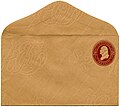
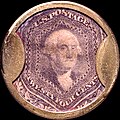




![Image 7Unissued 1956 £1 Jamaican chocolate and violet, the first stamp designed for Queen Elizabeth II. Held in the British Library Crown Agents Collection.[1]](http://upload.wikimedia.org/wikipedia/commons/thumb/9/9b/Stamp_Jamaica_1956_unissued_1sh.jpg/120px-Stamp_Jamaica_1956_unissued_1sh.jpg)








